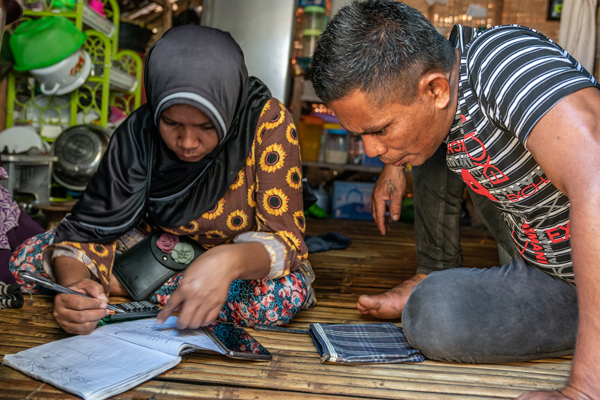Efforts to reduce overfishing and protect critical near-shore ocean habitats often prioritize working with men seen from shore, fishing in small boats, individually or in groups, at any hour of the day. But focusing only on men ignores an entire group of people who make the fish’s journey from the sea to the market possible: women.
Globally, women’s contributions to the fishing sector have been historically undervalued and overlooked. But women play an essential role in fisheries, especially in the small-scale fisheries that are critical as food and income for coastal communities. Through Rare’s Fish Forever program in Indonesia, Rare and KIT Royal Tropical Institute, with support from the Dutch Postcode Lottery, are focused on empowering women: integrating them into fisheries management, improving their financial resilience, and strengthening their participation in local value chains. In this first phase of the work, Rare and KIT aim to reach more than 10,000 fishing households and indirectly impact over 70,000 people across 40 communities where Rare currently works.
The roles of men and women in fisheries management are still limited to the narrow perception that “fisheries” are limited to fishing, and the actors are fisher-MEN. In reality, fisheries involve many actors, including women.”
– Eva Medianti, an expert on financial inclusion with Rare in Indonesia
The role of the male fisher is undoubtedly important. But the act of harvesting fish from the ocean is just one part of the process of bringing fish into the hands of consumers. Women in coastal fishing communities often start their days well before dawn and end them well after sunset. They help collect and prepare bait, mend nets, and repair boats. They can also be active fishers, especially near shore, where they may collect shellfish by hand. Women dominate the value chain to sort, process, sell, and trade fish. Many women are also responsible for recording their husbands’ catch, managing the family finances, caring for their children, and cooking and cleaning for their households.
Women’s free physical and emotional labor, from sunup to sundown, comes at a cost. According to the team at KIT, “Not looking at gender risks reducing the effectiveness of targeted interventions, perpetuates inequities, and impedes the achievement of food and nutrition security.”
 However, “When women participate in making important decisions for their households, communities, and ecosystems, we strengthen the entire rural economy and better sustain coastal waters and life above and below it,” says Dr. Steve Box, who leads Rare’s Fish Forever program globally.
However, “When women participate in making important decisions for their households, communities, and ecosystems, we strengthen the entire rural economy and better sustain coastal waters and life above and below it,” says Dr. Steve Box, who leads Rare’s Fish Forever program globally.
To accentuate the point that women’s contributions are undervalued and ignored, a recent study, led by Dr. Sarah Harper and conducted in collaboration with the Sea Around Us initiative and featured in Forbes, found that women in near-shore fisheries contribute about 11% of global catch from small-scale fisheries and about 12% of these fisheries’ value. The authors underscore the need for better data collection and accounting of women’s efforts: “Understanding the role of women and gender in these systems is crucial for developing effective policies and programs that strike a balance between the sustainability of fisheries resources and the viability of fishing communities.”
Strengthening women’s voices and enhancing their decision-making power in fisheries management, financial management, and the fisheries value chain will help ensure that there are fish for the future. The new partnership between Rare and KIT combines Rare’s strengths in community engagement and behavioral science with KIT’s expertise in community development with a focus on including and empowering women. The partnership involves working with communities to form fisheries management bodies that are inclusive and transparent and meet the needs of both men and women. The project also promotes access to and use of financial services to fisher households and small businesses. It further identifies opportunities to reduce post-harvest losses and improve household, micro, and small business management.
Medianti summarizes the rapid need to integrate women: “When we take women’s roles and interests in fisheries seriously, women can voice their opinion, needs, and suggestions, which should help to escalate more sustainable fisheries management.”
References
Harper, S., et al. (2020). Valuing invisible catches: Estimating the global contribution by women to small-scale marine capture fisheries production. Plos One. doi: https://doi.org/10.1371/journal.pone.0228912
Simke, A. (2020, March 8). The Invisible Women Of Small Scale Fisheries Contribute 11% Of Global Catch. Forbes. Retrieved from http://www.forbes.com.